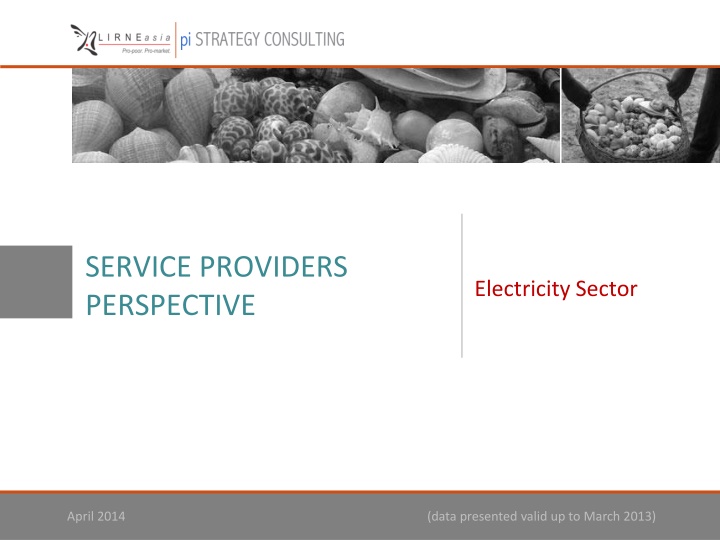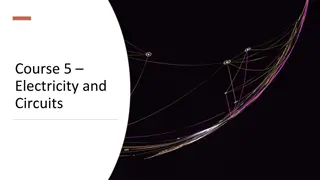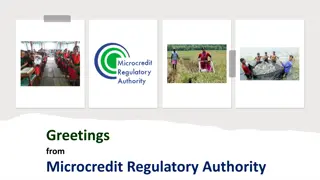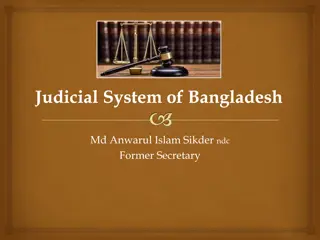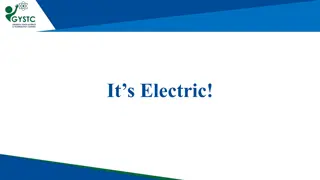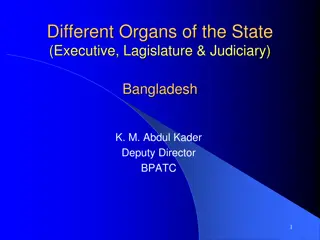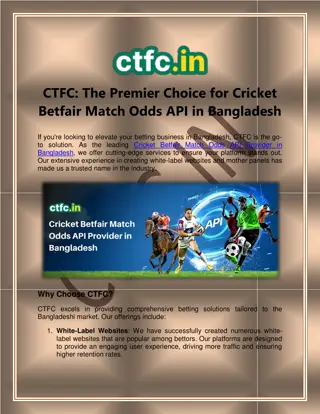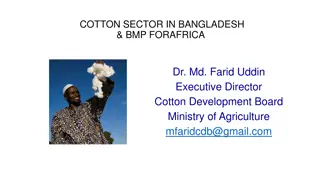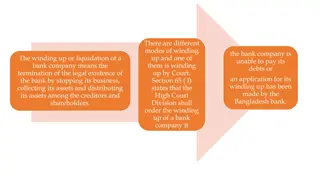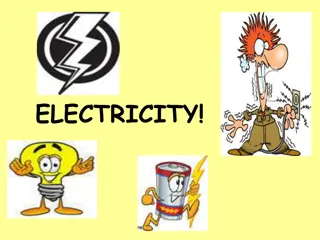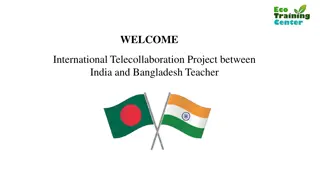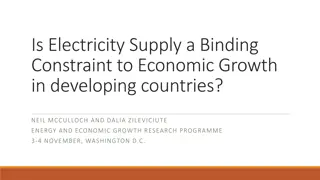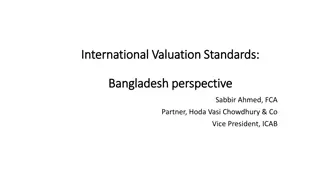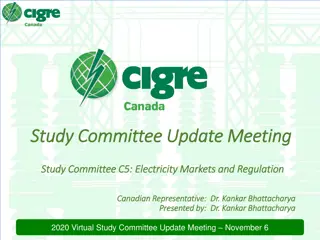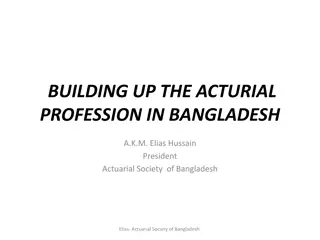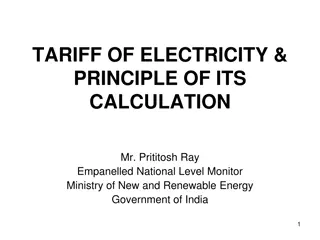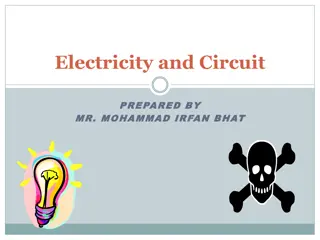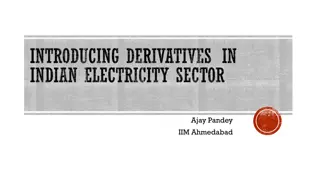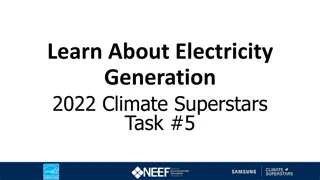Insights into the Electricity Sector of Bangladesh
The electricity sector in Bangladesh has around 13.5 million connections, with half of the population having access to electricity. The sector is dominated by key players like REB, BPDB, and DPDC. Renewable energy, particularly solar, is growing rapidly but still contributes only 0.5% to total electricity capacity. CRM practices are being utilized in the sector to enhance customer services. The current state assessment focuses on understanding CRM practices and service quality provided by distributors using a customer life cycle model.
Download Presentation

Please find below an Image/Link to download the presentation.
The content on the website is provided AS IS for your information and personal use only. It may not be sold, licensed, or shared on other websites without obtaining consent from the author.If you encounter any issues during the download, it is possible that the publisher has removed the file from their server.
You are allowed to download the files provided on this website for personal or commercial use, subject to the condition that they are used lawfully. All files are the property of their respective owners.
The content on the website is provided AS IS for your information and personal use only. It may not be sold, licensed, or shared on other websites without obtaining consent from the author.
E N D
Presentation Transcript
SERVICE PROVIDERS PERSPECTIVE Electricity Sector April 2014 (data presented valid up to March 2013)
Context At present, there are around 13.5 million electricity connections in Bangladesh. Approximately, half of the total population has access to electricity. Major actors in the power sector of Bangladesh are: Power Division Regulation Power Cell EA & CEI EMU BPDB APSCL EGCB RPCL IPP SIPP Generation NWZPGC B E R C PGCB Transmission Distribution BPDB REB DESCO DPDC WZPDC SZPDC NWZPDC PBS At present, there are seven distributors in the country. Three more distribution companies are getting ready to launch within the next few years. 2
Context (contd.) REB leads the distribution sector both in terms of the number of connections (around 68%) and consumption (around 36%). However, the per capita consumption is higher in mostly urban areas where DESCO, DPDC, BPDB are the major distributors. 80% 70% = - 31.17% 60% 50% 40% 30% = + 6.47% = + 15.06% 20% = + 7.24% 10% = + 1.62% = + 0.77% 0% REB BPDB DPDC DESCO WZPDC NWZPDC & SZPDC Percentage (In terms of Consumption) Percentage (In terms of Connection) (Source: Website of Distributors) 3
Context (contd.) Renewable energy sector has been growing rapidly in Bangladesh. It includes both solar energy and bio-gas; solar is the torch-bearer of innovations, including in areas of customer service. Solar: over 30 companies; up to 2013 the total number of SHSs (Solar Home System) installed across the country is around 2.7 million. (5 times than the number of Desco s connection); but contributes only 0.5% of total electricity capacity; only offered in off-grid areas. CRM practices in the solar space: Basic call center functions among the market leaders; can call someone to get service. Monthly service visits (coinciding with payment collection visits). Micro-entrepreneurs (mostly women) trained to offer basic troubleshooting services across rural communities. 4
Current State Assessment To better understand the current CRM practices in the power sector of Bangladesh and the quality of different services offered by the distributors, a standard customer life cycle (CLC) model has been utilized. Targeting Enquiry Management Winback Managing Problems Welcoming Customer Development Getting to Know Customers 5
Current State Assessment (contd.) Targeting In Bangladesh, there is zero competition in the distribution sector at a geographic level. Because electricity is viewed as a necessity, targeting potential customers (and associated activities such as marketing) by a distributor is not something what is seen in practice. Rather, customers are found waiting in long queues to get an electricity connection. Enquiry Management In most cases, customers learn about the steps to get a connection by making calls or browsing the websites (except NWZPDC, SZPDC). The application form can be obtained from the customer service center or zonal office and also from the websites. Customers are often assisted with the application form filling-in process if they visit the offices of the distributors. However, such assistance through phone or email is rare. 6
Current State Assessment (contd.) Welcoming In most customer service centers (aka One Point Service Centers ) customer is provided with a serial number. According to the serial number provided, she is called to a counter where she can inquire about getting a connection and the necessary procedures. Only DESCO offers a 24/7 call center. Distributors have brochures/leaflets on different services they are offering to the customers. Anyone can get a good sense of the customer s rights and obligations from these publications. Getting to know Customers Basic KYC information collected for new customers (during signup). No specific examples found of surveys, analysis etc. to identify unmet or latent needs of potential customers. So far, none of the distributors were found conducting any large scale survey to collect usage data and perform analysis thereafter as a part of getting to know existing customers better. 7
Current State Assessment (contd.) Customer Development All distributors, except REB, provide load-shedding forecasts on their websites. With the help of the service, one can get a clear picture of the probable number of hours of load-shedding in their respective areas over the proceeding week. Distribution companies conduct awareness campaigns on energy savings by advertising in newspapers, televisions, websites and billboards. For visits to homes, the residents are informed in advance largely through public announcements (often made through microphones from a traveling rickshaw) and in some cases, through newspapers. Special efforts are made around the bill payment process: Billing month is not necessarily the calendar month. Rather it is decided based on the meter reading schedule. Usually, the schedule remains same for a particular customer and she is kept informed. The bill is issued in paper format, it is easy to understand and contains detailed breakdown of fixed charge, usage charge, taxes and surcharges. Customer can pay bill through designated bank branches, customer service centers, mobile phones and the internet. First three options are available for any distributors, whereas DESCO and REB also offer the online bill payment service. 8
Current State Assessment (contd.) Managing Problems At a customer service center, customers can lodge a complaint in person. To better address and trace the grievance, a reference number is provided. Time required to resolve a complaint varies. However, DESCO provides a list of services along with the respective time requirement to solve an issue. (see next slide) For illegal connections and usage, tampering meter readings or any such issues, distributers can take legal actions according to the Electricity Act of Bangladesh. For illegal usage there is also a provision of issuing penal bills, which is three times the actual rate. 9
Current State Assessment (contd.) Example: DESCO provides a list of services along with the respective time requirement to solve an issue. Description Queries for not getting monthly Bill Bill re-print Correcting the amount in bill Removing from the defaulter list after paying due bill Not receiving acknowledgement of bill payment Re-connection after getting due payment within 15 days of cut off (regular case) Req. Working days 7 Instant 7 7 5 1 Re-connection after getting due payment (cut off due to illegal usage) 3 Re-connection after malfunctioning of the meter (service dropped, burnt, damaged, theft) Changing the name of consumer in existing connection Meter (less than 50KW) examine after applying with due charge 2 5 7 Meter (equal or more than 50KW) examine after applying with due charge Changing Tariff Withdrawal of security deposit after temporary connection 15 5 14 Win back Since there is a single distributor for a particular region, customers don t really have the option to switch distributing companies. Therefore, winning back a customer is not relevant (yet) in Bangladesh. 10
Current State Assessment (contd.) Following chart summarizes some of the major customer services provided by the distribution companies. Service Name BPDB REB DESCO DPDC WZPDC NWZPDC SZPDC Online Application N/A N/A Online bill payment N/A N/A Mobile bill Payment N/A N/A Load Shedding Forecasting N/A N/A Help Line N/A N/A 24/7 Call Center N/A N/A Customer Service Center N/A N/A SMS notification N/A N/A Pre paid meter (Source: Website of Distributors; Interviews; N/A = Not Available) N/A N/A 11
Current State Assessment (contd.) Pre-paid Meters In order to limit the scope of unfair billing, both DESCO and BPDB have piloted pre-paid meter in some service areas. At present, there are 57,000 pre-paid meters deployed. DESCO has two vending stations to provide recharge and other services. BPDB is offering customer services to pre-paid users through existing networks of customer service points. Each pre-paid meter costs about US$50. Power Division has launched a 5-year scheme to introduce pre-paid meters across the country starting from 2013. However, these meters are different from the meters installed by DESCO and PDB. These meters will have the ability to control high-load during peak hours. At the time of re-charging, the vending station s computer reads all the consumption information of the consumer in the consumer-database, which helps to analyze the consumer's electricity usage behavior. After re-charging when consumer inserts her smart card into the meter, the meter reads the card and downloads the amount of electricity bill that has been paid for. 12
Challenges One of the biggest concerns in the power sector observed over the last few years in Bangladesh is the tariff hike. BERC has raised electricity tariff four times within around a year. A general consumer is paying around 50% higher prices than what she used to pay in 2011. 14% 7.0 12% 6.0 10% 5.0 Retail Price per unit Percentage 8% 4.0 6% 3.0 4% 2.0 2% 1.0 0% 0.0 Mar, 2010 Feb, 2011 Dec, 2011 Feb, 2012 Mar, 2012 Sep, 2012 Mar, 2013 Retail Price per unit (BDT) % increase in retail price per unit 13
Challenges (contd.) Monopolistic Market Condition While Customer Relationship Management is a tool of great importance to obtain competitive edge over other competitors, being the sole player in a particular geography (in effect a monopoly) has not been providing enough incentives to the distributors to better serve the customers and keep them satisfied. Poorly Designed Services Despite some recent initiatives by the distributors to better serve the customers by introducing online/mobile services, most of the customer services still remain poor due to weak design of such services. For instance, on the DESCO website, anyone can check the consumption and billing history of DESCO consumers if she knows the account number of a consumer. As there is no password verification/authentication in the system, this poses a serious threat to the privacy of the consumers. 14
Challenges (contd.) Lack of Automated Processes The level of human interaction and paper-based processes throughout the customer management system is a hindrance to the work process; this also creates scope for informal payments. To get a desired service, in most of the cases, consumers require clearances from multiple actors, which contribute to lengthening the process and opening up opportunities for mal-governance. Customers not Well-informed Customers are often unaware of their rights and as long as customers remain unaware of their rights, they will not demand better services. The Consumers Association of Bangladesh (CAB) is the only organization that works on consumer protection rights; however, in the recent past they have limited their activities to address bigger challenges such as price hikes rather than addressing challenges such as weak CRM practices. 15
